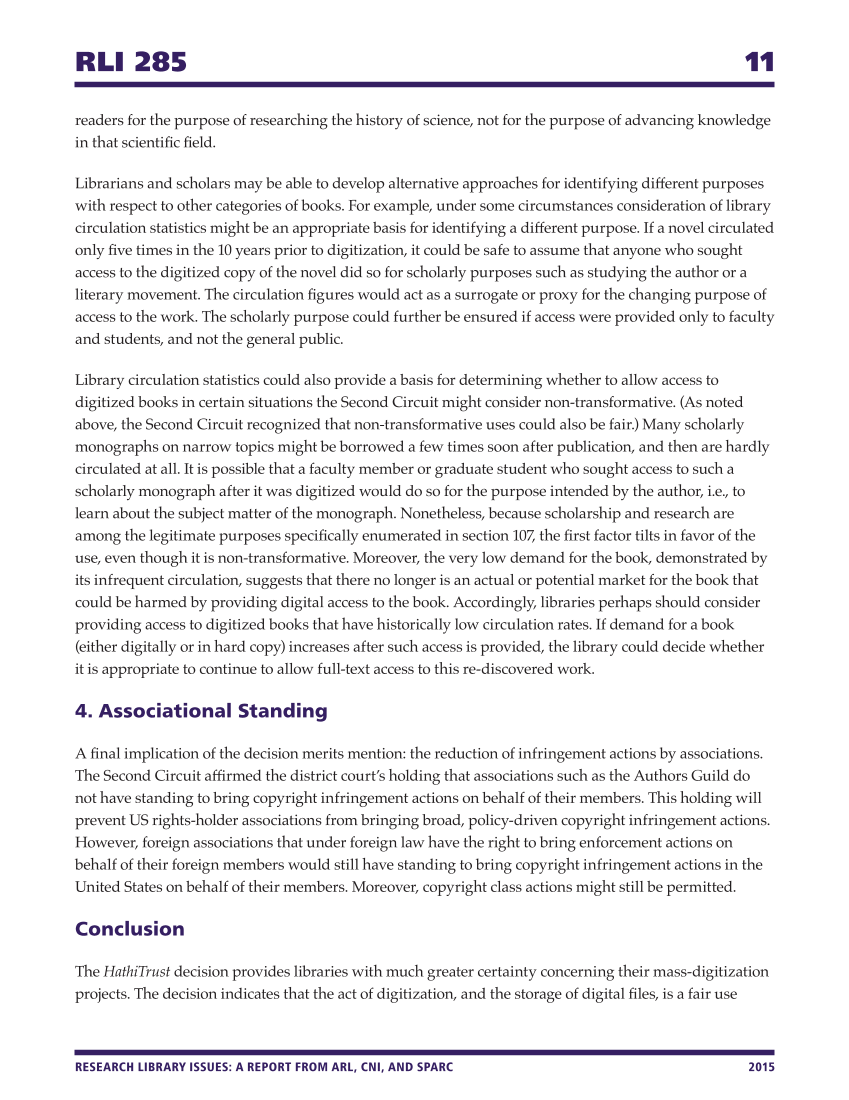RLI 285 11 RESEARCH LIBRARY ISSUES: A REPORT FROM ARL, CNI, AND SPARC 2015 readers for the purpose of researching the history of science, not for the purpose of advancing knowledge in that scientific field. Librarians and scholars may be able to develop alternative approaches for identifying different purposes with respect to other categories of books. For example, under some circumstances consideration of library circulation statistics might be an appropriate basis for identifying a different purpose. If a novel circulated only five times in the 10 years prior to digitization, it could be safe to assume that anyone who sought access to the digitized copy of the novel did so for scholarly purposes such as studying the author or a literary movement. The circulation figures would act as a surrogate or proxy for the changing purpose of access to the work. The scholarly purpose could further be ensured if access were provided only to faculty and students, and not the general public. Library circulation statistics could also provide a basis for determining whether to allow access to digitized books in certain situations the Second Circuit might consider non-transformative. (As noted above, the Second Circuit recognized that non-transformative uses could also be fair.) Many scholarly monographs on narrow topics might be borrowed a few times soon after publication, and then are hardly circulated at all. It is possible that a faculty member or graduate student who sought access to such a scholarly monograph after it was digitized would do so for the purpose intended by the author, i.e., to learn about the subject matter of the monograph. Nonetheless, because scholarship and research are among the legitimate purposes specifically enumerated in section 107, the first factor tilts in favor of the use, even though it is non-transformative. Moreover, the very low demand for the book, demonstrated by its infrequent circulation, suggests that there no longer is an actual or potential market for the book that could be harmed by providing digital access to the book. Accordingly, libraries perhaps should consider providing access to digitized books that have historically low circulation rates. If demand for a book (either digitally or in hard copy) increases after such access is provided, the library could decide whether it is appropriate to continue to allow full-text access to this re-discovered work. 4. Associational Standing A final implication of the decision merits mention: the reduction of infringement actions by associations. The Second Circuit affirmed the district court’s holding that associations such as the Authors Guild do not have standing to bring copyright infringement actions on behalf of their members. This holding will prevent US rights-holder associations from bringing broad, policy-driven copyright infringement actions. However, foreign associations that under foreign law have the right to bring enforcement actions on behalf of their foreign members would still have standing to bring copyright infringement actions in the United States on behalf of their members. Moreover, copyright class actions might still be permitted. Conclusion The HathiTrust decision provides libraries with much greater certainty concerning their mass-digitization projects. The decision indicates that the act of digitization, and the storage of digital files, is a fair use























